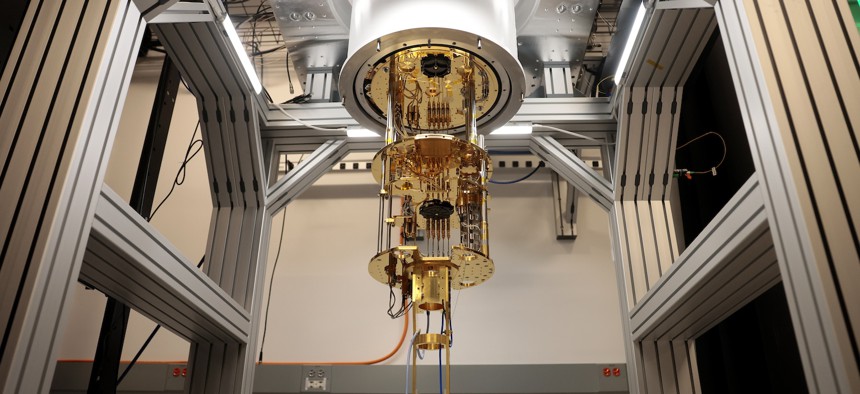Practical quantum computing is coming in 3 to 5 years, but will be cloud based, NSA official predicts

A dilution refrigerator inside Amazon Web Services' quantum networking lab in Brighton, Mass. Jessica Rinaldi/The Boston Globe via Getty Images
Cloud architectures will allow organizations to more easily access quantum capabilities, he said.
Practical quantum computing tools are about 3 to 5 years out from workforce use and will likely be accessed through cloud based environments, a top National Security Agency official predicted at a Tuesday Palo Alto Networks public sector cybersecurity event.
Neal Ziring, the NSA’s cybersecurity directorate’s technical director, said that quantum computing systems — which use the laws of quantum mechanics to solve problems at an exponentially faster rate than traditional computers and are still largely theoretical — will likely be accessed via cloud computing platforms rather than on-premise installs, due to cost and practicality considerations.
“Even if a government agency would be willing to have one quantum computer on-prem … I don't think they’re going to be willing to have multiple,” he said.
The intelligence community faces many of the same data processing challenges as the civilian world, he said, noting that the NSA is “very wary of adding complexity where it’s not needed.”
The cloud aspect would help users mesh together uses for both quantum computers and classical computers, known as hybrid computing, in which the computational elements of both systems are combined for problem solving.
“In the long term, I think we really need to move as a community towards using the quantum algorithms on their own to avoid the complexity and performance overhead,” said Ziring, who will soon be transitioning to a management position at the NSA’s Research directorate.
Some steps will still be needed to make his prediction come to fruition, Ziring noted. Those will include further research into quantum circuits, which determine the optimal pathways that quantum particles need to follow to successfully execute operations.
Quantum computing, while a nascent technology in practical terms, is viewed as an emerging paradigm that will likely help the intelligence community and Department of Defense enhance their cybersecurity and logistics capabilities. The White House and intelligence partners have been working to bolster government network defenses that aim to prevent systems from being vulnerable to advanced techniques enabled by the creation of practical quantum computers in the near future.
The NSA, in particular, has set a 2035 deadline for IC systems to be locked into these new standards, known as post-quantum cryptography.
Thought leaders in the federal government are trying to prevent quantum-powered cyber incidents like “record now, decrypt later” attacks where an adversary will hoover up encrypted data streams, store them, and — with the eventual existence of a powerful enough quantum device — decrypt that data to use for theft or exploitation.
President Joe Biden in 2022 signed a National Security Memorandum directing the U.S. to maintain global leadership in quantum research.
“A quantum computer of sufficient size and sophistication … will be capable of breaking much of the public-key cryptography used on digital systems across the United States and the world,” an NSA readout said at the time of the signing.
The 2024 defense policy bill has a provision that requires “a report on the feasibility of establishing a quantum computing innovation center within the Department of Defense.”
For now, the U.S. is still in a “good spot” to take advantage of quantum, but better partnerships between government, industry and academia will be needed to reap the full benefits of the nascent technology, Ziring said.



